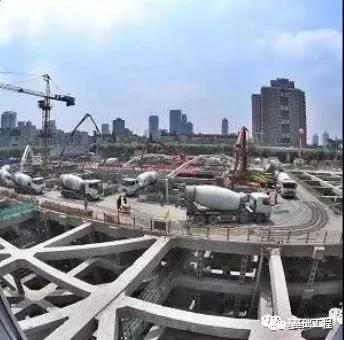With the continuous development of underground engineering construction in my country, there are more and more deep foundation pit projects. The construction process is relatively complicated, and groundwater will also have a certain impact on construction safety. In order to ensure the quality and safety of the project, effective waterproofing measures should be taken during the construction of deep foundation pits to reduce the risks brought to the project by leakage. This article mainly discusses the waterproofing technology of deep foundation pits from several aspects, including the enclosure structure, main structure, and waterproof layer construction.

Keywords: Deep foundation pit waterproofing; retaining structure; waterproof layer; key points of card control
In deep foundation pit projects, correct waterproofing construction is crucial to the overall structure, and will also have a great impact on the service life of the building. Therefore, waterproofing projects occupy a very important position in the construction process of deep foundation pits. This paper mainly combines the deep foundation pit construction process characteristics of Nanning Metro and Hangzhou South Station building projects to study and analyze the deep foundation pit waterproofing technology, hoping to provide certain reference value for similar projects in the future.
1. Retaining structure waterproofing
(I) Water-stopping characteristics of various retaining structures
The vertical retaining structure around the deep foundation pit is generally called the retaining structure. The retaining structure is a prerequisite for ensuring the safe excavation of the deep foundation pit. There are many structural forms used in deep foundation pits, and their construction methods, processes and construction machinery used are different. The water-stopping effects achieved by various construction methods are not the same, see Table 1 for details
(II) Waterproofing precautions for ground-connected wall construction
The foundation pit construction of Nanhu Station of Nanning Metro adopts a ground-connected wall structure. The ground-connected wall has a good waterproofing effect. The construction process is similar to that of bored piles. The following points should be noted
1. The key point of waterproofing quality control lies in the joint treatment between the two walls. If the key points of joint treatment construction can be grasped, a good waterproofing effect will be achieved.
2. After the groove is formed, the end faces of the adjacent concrete should be cleaned and brushed to the bottom. The number of wall brushings should not be less than 20 times until there is no mud on the wall brush.
3. Before the steel cage is lowered, a small conduit is installed at the end of the steel cage along the wall direction. During the installation process, the quality of the joint is strictly controlled to prevent leakage from clogging the conduit. During the excavation of the foundation pit, if water leakage is found at the wall joint, grouting is performed from the small conduit.
(III) Waterproofing focus of cast-in-place pile construction
Some retaining structures of Hangzhou South Station adopt the form of bored cast-in-place pile + high-pressure rotary jet pile curtain. Controlling the construction quality of high-pressure rotary jet pile water-stop curtain during construction is the key point of waterproofing. During the construction of the water-stop curtain, the pile spacing, slurry quality and injection pressure must be strictly controlled to ensure that a closed waterproof belt is formed around the cast-in-place pile to achieve a good waterproofing effect.
2. Foundation pit excavation control
During the foundation pit excavation process, the retaining structure may leak due to improper treatment of the retaining structure nodes. In order to avoid accidents caused by water leakage of the retaining structure, the following points should be noted during the foundation pit excavation process:
1. During the excavation process, blind excavation is strictly prohibited. Pay close attention to the changes in the water level outside the foundation pit and the seepage of the retaining structure. If water gushing occurs during the excavation process, the gushing position should be backfilled in time to prevent expansion and instability. Excavation can only be continued after the corresponding method is adopted. 2. Small-scale seepage water should be handled in time. Clean the concrete surface, use high-strength quick-setting cement to seal the wall, and use a small duct to drain to prevent the leakage area from expanding. After the sealing cement reaches the strength, use a grouting machine with grouting pressure to seal the small duct.
3. Waterproofing of the main structure
Waterproofing of the main structure is the most important part of deep foundation pit waterproofing. By controlling the following aspects, the main structure can achieve good waterproofing effect.
(I) Concrete quality control
Concrete quality is the premise to ensure structural waterproofing. The selection of raw materials and the designer of the mix ratio ensure the supporting conditions of concrete quality.
The aggregate entering the site should be inspected and accepted in accordance with the "Standards for the Quality and Inspection Methods of Sand and Stone for Ordinary Concrete" for mud content, mud block content, needle-like content, particle grading, etc. Ensure that the sand content is as low as possible under the premise of meeting the strength and workability, so that there is enough coarse aggregate in the concrete. The concrete component mix ratio should meet the strength requirements of the concrete structure design, durability under various environments, and make the concrete mixture have working properties such as flowability that adapts to construction conditions. The concrete mixture should be uniform, easy to compact and anti-segregation, which is the premise for improving the quality of concrete. Therefore, the workability of concrete should be fully guaranteed.
(II) Construction control
1. Concrete treatment. The construction joint is formed at the junction of new and old concrete. The roughening treatment effectively increases the bonding area of new and old concrete, which not only improves the continuity of concrete, but also helps the wall to resist bending and shear. Before pouring concrete, the clean slurry is spread and then coated with cement-based anti-seepage crystalline material. Cement-based anti-seepage crystalline material can well bond the gaps between concrete and prevent external water from invading.
2. Installation of steel plate waterstop. The waterstop steel plate should be buried in the middle of the poured concrete structure layer, and the bends at both ends should face the water-facing surface. The waterstop steel plate of the construction joint of the exterior wall post-casting belt should be placed in the middle of the concrete exterior wall, and the vertical setting and each horizontal waterstop steel plate should be welded tightly. After the horizontal elevation of the horizontal steel plate waterstop is determined, a line should be drawn at the upper end of the steel plate waterstop according to the elevation control point of the building to keep its upper end straight.
Steel plates are fixed by steel bar welding, and oblique steel bars are welded to the top formwork stick for fixing. Short steel bars are welded under the steel plate waterstop to support the steel plate. The length should be based on the thickness of the concrete slab wall steel mesh and should not be too long to prevent the formation of water seepage channels along the short steel bars. The short steel bars are generally spaced no more than 200mm apart, with one set on the left and right. If the spacing is too small, the cost and engineering volume will increase. If the spacing is too large, the steel plate waterstop is easy to bend and easy to deform due to vibration when pouring concrete.
The steel plate joints are welded, and the lap length of the two steel plates is not less than 50mm. Both ends should be fully welded, and the weld height is not less than the thickness of the steel plate. Before welding, a trial welding should be carried out to adjust the current parameters. If the current is too large, it is easy to burn or even burn through the steel plate. If the current is too small, it is difficult to start the arc and the welding is not firm.
3. Installation of water-expanding waterstop strips. Before laying the water-swelling waterstop strip, sweep away the scum, dust, debris, etc., and expose the hard base. After construction, pour the ground and horizontal construction joints, expand the water-swelling waterstop strip along the extension direction of the construction joint, and use its own adhesiveness to stick it directly in the middle of the construction joint. The joint overlap should not be less than 5cm, and no breakpoints should be left; for the vertical construction joint, a shallow positioning groove should be reserved first, and the waterstop strip should be embedded in the reserved groove; if there is no reserved groove, high-strength steel nails can also be used for fixing, and use its self-adhesiveness to stick it directly on the construction joint interface, and evenly compact it when it encounters isolation paper. After the waterstop strip is fixed, tear off the isolation paper and pour the concrete.
4. Concrete vibration. The time and method of concrete vibration must be correct. It must be vibrated densely but not over-vibrated or leaked. During the vibration process, the mortar splashing should be minimized, and the mortar splashed on the inner surface of the formwork should be cleaned in time. The concrete vibration points are divided from the middle to the edge, and the rods are evenly laid, layer by layer, and each part of the concrete pouring should be poured continuously. The vibration time of each vibration point should be based on the concrete surface being floating, flat, and no more bubbles coming out, usually 20-30s, to avoid segregation caused by over-vibration.
Concrete pouring should be carried out in layers and continuously. The insertion vibrator should be inserted quickly and pulled out slowly, and the insertion points should be evenly arranged and arranged in a plum blossom shape. The vibrator for vibrating the upper layer of concrete should be inserted into the lower layer of concrete by 5-10cm to ensure that the two layers of concrete are firmly combined. The direction of the vibration sequence should be as opposite as possible to the direction of concrete flow, so that the vibrated concrete will no longer enter free water and bubbles. The vibrator must not touch the embedded parts and formwork during the vibration process.
5. Maintenance. After the concrete is poured, it should be covered and watered within 12 hours to keep the concrete moist. The maintenance period is generally not less than 7 days. For parts that cannot be watered, a curing agent should be used for maintenance, or a protective film should be sprayed directly on the concrete surface after demolding, which can not only avoid maintenance, but also improve durability.
4. Laying of waterproof layer
Although deep foundation pit waterproofing is mainly based on concrete self-waterproofing, laying of waterproof layer also plays a vital role in deep foundation pit waterproofing projects. Strictly controlling the construction quality of waterproof layer is the key point of waterproof construction.
(I) Base surface treatment
Before laying the waterproof layer, the base surface should be effectively treated, mainly for flatness and water seepage treatment. If there is water seepage on the base surface, the leak should be treated by plugging. The treated base surface must be clean, pollution-free, water droplet-free, and water-free.
(II) Laying quality of waterproof layer
1. The waterproof membrane must have a factory certificate, and only qualified products can be used. The waterproof construction foundation should be flat, dry, clean, solid, and not sandy or peeling. 2. Before the waterproof layer is applied, the base corners should be treated. The corners should be made into arcs. The diameter of the inner corner should be greater than 50mm, and the diameter of the outer corner should be greater than 100mm. 3. The waterproof layer construction must be carried out in accordance with the specifications and design requirements. 4. Process the construction joint position, determine the height of concrete pouring, and perform waterproof reinforcement treatment at the construction joint position. 5. After the base waterproof layer is laid, the protective layer should be constructed in time to avoid scalding and puncturing the waterproof layer during steel bar welding and damaging the waterproof layer during concrete vibrating.
V. Conclusion
The penetration and waterproofing common problems of underground projects seriously affect the overall construction quality of the structure, but it is not unavoidable. We mainly clarify the idea that "design is the premise, materials are the foundation, construction is the key, and management is the guarantee". In the construction of waterproof projects, strict control of the construction quality of each process and taking targeted preventive and control measures will surely achieve the expected goals.
Media Contact
Company Name: Shanghai Engineering Machinery Co.,Ltd.
Email: Send Email
Phone: 0086-21-66308831
Address:No.258 Yangnan Road
City: Shanghai, 201901
Country: China
Website: https://www.semw.com/





